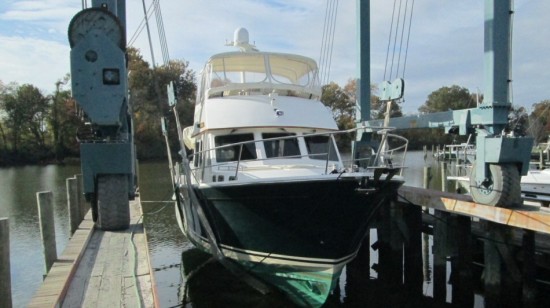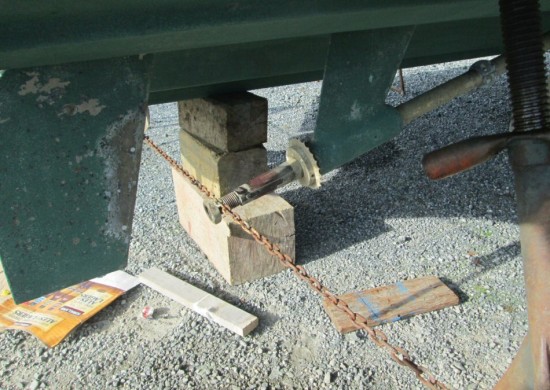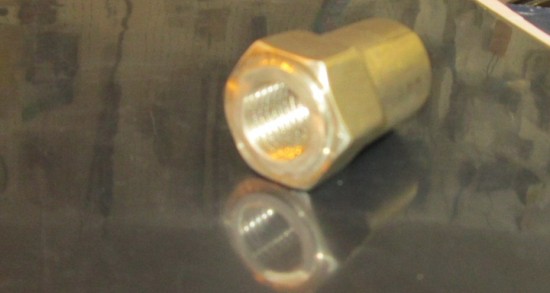It should be the last chilly day this week — the temps are supposed to rise tomorrow and stay that way through the weekend. I noticed a major jump in the statistics for the blog last night so maybe I should up the ante? Of course, this is the time of the year where everything is boring — just winterizing and haulouts.

We did get the prop of the Eastbay after a lot of time. The marina who had it off last time put something on the taper to keep it from seizing up on the shaft but it seemed to have the opposite effect.

Our secret is the
prop knocker. This screws on to the threaded portion and you “knock” it with a hammer. I’m not talking about “tapping” it — you actually have to put some a** into it! This works where other methods do not – especially on a five bladed prop. We have them custom made when we need them. Often we sell one to the customer so he will have it aboard if he runs into a problem again.

Since many readers never go to our website I like to offer some information you can find there occasionally just to make sure you get good coverage.
Marine Seacock Maintenance

Seacocks are your first line of defense against water entering your boat. They open and close for a reason and if they don’t operate properly they are an accident waiting to happen. If a hose bursts you must be able to close the seacock. To ensure proper operation, you must maintain them on a regular basis. What is involved depends on the type of seacock you have. Some seacocks are maintenance free, such as Apollo and Conbraco brands, while other require maintenance such as Perko and Groco style. The maintenance free styles should be operated frequently to ensure they don’t get stiff or stuck. Most of the other types have similar maintenance requirements.
Disassembling the Seacock
Maintenance style seacocks require disassembly of the seacock, which obviously has to be done while the boat is out of the water. The perfect time for this is when you are laid up for winter storage. While disassembling, we can ensure the seacock is properly bedded and fits snugly to hull. Also if the seacock is mounted on a backing block, we will make sure that it is stable and shows no signs of deterioration.
Lubricating
Once the seacock is disassembled, we clean clean salt, old grease and other debris from the drum and seacock passageways. Sometimes grit from sand will score the drum which will allow leakage through a closed seacock. This will need to be slightly sanded to allow a water tight fit. We then lubricate the drum with the proper lubricant and reinstall the drum in the seacock.
Other Types of Seacocks
We have seen all styles of seacocks on boats here in the marina. There are some we will immediately recommend replacing. First off, any gate valve mounted on a thruhull should be replaced, regardless of the use. Gate valves are susceptible to lots of problems and most do not have all rust proof parts. We would also recommend most plastic thruhulls below the water line be replaced. Some styles such as the Forespar, which is made from plastic impregnated with fiberglass, are heavy duty and are used primarily where weight is an issue such as in racing sailboats. Other boats don’t have the same restrictions and should stay with heavy bronze for the least amount of problems.
We also see thruhulls with a ball valve mounted on them. While this works, it is not really an acceptable practice. All seacocks should be mounted to the hull which will negate the possibility of it getting broken off as a ball valve could be.
Seacock Strainers

There may actually be two kinds of strainers on a seacock. One is on the outside of the hull and could be a scoop strainer or just a strainer cover. These keep larger debris from entering though the hull. It should also eliminate most jelly fish from getting sucked in. Maintenance on these strainers should be done while the bottom is being painted and simply involves removing from the hull, cleaning and painting inside and out to eliminate barnacles.
The other kind of strainers are basket strainers and could be mounted right to the seacock or remotely. In either case, these will need to be maintained. There are no moving parts so lubrication is not an issue, but cleanliness is. These have glass or heavy plastic so you can visually inspect for debris. If you can’t see through them, clean them immediately. Secondly, most have baskets inside. Groco makes 2 types of baskets — monel or plastic. We prefer the plastic. Aside from being cheaper, they do not corrode over time as the monel do. We have removed baskets with holes the size of golf balls in them. These will allow debris to enter the system and essentially negating the strainer from the system.
You also want the strainer to be leak-free which will mean occasionally you will need to replace the seals. Most strainers have 3 seals – one at the top and bottom of the glass and one under the removable lid. The one on the lid is the most usual one to replace since you will be opening the strainer a lot to dump the basket (hopefully).

Above is a strainer basket we found during the winterization of a boat. The use of plastic baskets will eliminate this type of deterioration. The owner obviously has not been maintaining these.
 We did get the prop of the Eastbay after a lot of time. The marina who had it off last time put something on the taper to keep it from seizing up on the shaft but it seemed to have the opposite effect.
We did get the prop of the Eastbay after a lot of time. The marina who had it off last time put something on the taper to keep it from seizing up on the shaft but it seemed to have the opposite effect.
 Our secret is the prop knocker. This screws on to the threaded portion and you “knock” it with a hammer. I’m not talking about “tapping” it — you actually have to put some a** into it! This works where other methods do not – especially on a five bladed prop. We have them custom made when we need them. Often we sell one to the customer so he will have it aboard if he runs into a problem again.
Our secret is the prop knocker. This screws on to the threaded portion and you “knock” it with a hammer. I’m not talking about “tapping” it — you actually have to put some a** into it! This works where other methods do not – especially on a five bladed prop. We have them custom made when we need them. Often we sell one to the customer so he will have it aboard if he runs into a problem again.
 Since many readers never go to our website I like to offer some information you can find there occasionally just to make sure you get good coverage.
Since many readers never go to our website I like to offer some information you can find there occasionally just to make sure you get good coverage.
 Seacocks are your first line of defense against water entering your boat. They open and close for a reason and if they don’t operate properly they are an accident waiting to happen. If a hose bursts you must be able to close the seacock. To ensure proper operation, you must maintain them on a regular basis. What is involved depends on the type of seacock you have. Some seacocks are maintenance free, such as Apollo and Conbraco brands, while other require maintenance such as Perko and Groco style. The maintenance free styles should be operated frequently to ensure they don’t get stiff or stuck. Most of the other types have similar maintenance requirements.
Disassembling the Seacock
Maintenance style seacocks require disassembly of the seacock, which obviously has to be done while the boat is out of the water. The perfect time for this is when you are laid up for winter storage. While disassembling, we can ensure the seacock is properly bedded and fits snugly to hull. Also if the seacock is mounted on a backing block, we will make sure that it is stable and shows no signs of deterioration.
Lubricating
Once the seacock is disassembled, we clean clean salt, old grease and other debris from the drum and seacock passageways. Sometimes grit from sand will score the drum which will allow leakage through a closed seacock. This will need to be slightly sanded to allow a water tight fit. We then lubricate the drum with the proper lubricant and reinstall the drum in the seacock.
Other Types of Seacocks
We have seen all styles of seacocks on boats here in the marina. There are some we will immediately recommend replacing. First off, any gate valve mounted on a thruhull should be replaced, regardless of the use. Gate valves are susceptible to lots of problems and most do not have all rust proof parts. We would also recommend most plastic thruhulls below the water line be replaced. Some styles such as the Forespar, which is made from plastic impregnated with fiberglass, are heavy duty and are used primarily where weight is an issue such as in racing sailboats. Other boats don’t have the same restrictions and should stay with heavy bronze for the least amount of problems.
We also see thruhulls with a ball valve mounted on them. While this works, it is not really an acceptable practice. All seacocks should be mounted to the hull which will negate the possibility of it getting broken off as a ball valve could be.
Seacocks are your first line of defense against water entering your boat. They open and close for a reason and if they don’t operate properly they are an accident waiting to happen. If a hose bursts you must be able to close the seacock. To ensure proper operation, you must maintain them on a regular basis. What is involved depends on the type of seacock you have. Some seacocks are maintenance free, such as Apollo and Conbraco brands, while other require maintenance such as Perko and Groco style. The maintenance free styles should be operated frequently to ensure they don’t get stiff or stuck. Most of the other types have similar maintenance requirements.
Disassembling the Seacock
Maintenance style seacocks require disassembly of the seacock, which obviously has to be done while the boat is out of the water. The perfect time for this is when you are laid up for winter storage. While disassembling, we can ensure the seacock is properly bedded and fits snugly to hull. Also if the seacock is mounted on a backing block, we will make sure that it is stable and shows no signs of deterioration.
Lubricating
Once the seacock is disassembled, we clean clean salt, old grease and other debris from the drum and seacock passageways. Sometimes grit from sand will score the drum which will allow leakage through a closed seacock. This will need to be slightly sanded to allow a water tight fit. We then lubricate the drum with the proper lubricant and reinstall the drum in the seacock.
Other Types of Seacocks
We have seen all styles of seacocks on boats here in the marina. There are some we will immediately recommend replacing. First off, any gate valve mounted on a thruhull should be replaced, regardless of the use. Gate valves are susceptible to lots of problems and most do not have all rust proof parts. We would also recommend most plastic thruhulls below the water line be replaced. Some styles such as the Forespar, which is made from plastic impregnated with fiberglass, are heavy duty and are used primarily where weight is an issue such as in racing sailboats. Other boats don’t have the same restrictions and should stay with heavy bronze for the least amount of problems.
We also see thruhulls with a ball valve mounted on them. While this works, it is not really an acceptable practice. All seacocks should be mounted to the hull which will negate the possibility of it getting broken off as a ball valve could be.
 There may actually be two kinds of strainers on a seacock. One is on the outside of the hull and could be a scoop strainer or just a strainer cover. These keep larger debris from entering though the hull. It should also eliminate most jelly fish from getting sucked in. Maintenance on these strainers should be done while the bottom is being painted and simply involves removing from the hull, cleaning and painting inside and out to eliminate barnacles.
The other kind of strainers are basket strainers and could be mounted right to the seacock or remotely. In either case, these will need to be maintained. There are no moving parts so lubrication is not an issue, but cleanliness is. These have glass or heavy plastic so you can visually inspect for debris. If you can’t see through them, clean them immediately. Secondly, most have baskets inside. Groco makes 2 types of baskets — monel or plastic. We prefer the plastic. Aside from being cheaper, they do not corrode over time as the monel do. We have removed baskets with holes the size of golf balls in them. These will allow debris to enter the system and essentially negating the strainer from the system.
You also want the strainer to be leak-free which will mean occasionally you will need to replace the seals. Most strainers have 3 seals – one at the top and bottom of the glass and one under the removable lid. The one on the lid is the most usual one to replace since you will be opening the strainer a lot to dump the basket (hopefully).
There may actually be two kinds of strainers on a seacock. One is on the outside of the hull and could be a scoop strainer or just a strainer cover. These keep larger debris from entering though the hull. It should also eliminate most jelly fish from getting sucked in. Maintenance on these strainers should be done while the bottom is being painted and simply involves removing from the hull, cleaning and painting inside and out to eliminate barnacles.
The other kind of strainers are basket strainers and could be mounted right to the seacock or remotely. In either case, these will need to be maintained. There are no moving parts so lubrication is not an issue, but cleanliness is. These have glass or heavy plastic so you can visually inspect for debris. If you can’t see through them, clean them immediately. Secondly, most have baskets inside. Groco makes 2 types of baskets — monel or plastic. We prefer the plastic. Aside from being cheaper, they do not corrode over time as the monel do. We have removed baskets with holes the size of golf balls in them. These will allow debris to enter the system and essentially negating the strainer from the system.
You also want the strainer to be leak-free which will mean occasionally you will need to replace the seals. Most strainers have 3 seals – one at the top and bottom of the glass and one under the removable lid. The one on the lid is the most usual one to replace since you will be opening the strainer a lot to dump the basket (hopefully).


